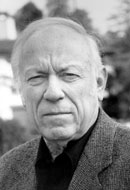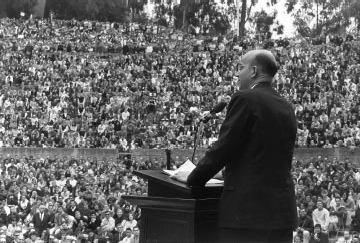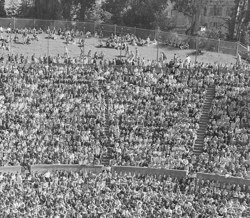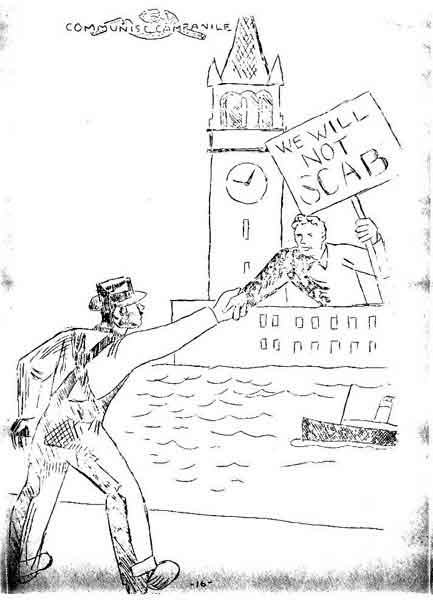This post is adapted from an assignment in a California history course.
In 1940, the Regents of the University of California dismissed teaching assistant Kenneth May on the grounds of his being an admitted Communist. Nine years later, the Regents formally amended an existing oath of allegiance to the California state constitution—to include an anti-communist clause, with the provision that “the foregoing statement is a condition of… employment.” Many professors refused to sign, and a few were fired. The ensuing conflict over this loyalty oath was largely limited to faculty members (via the Academic Senate and other groups) and the administrators concerned about their politics. But students, too, were drawn into the controversy. In a few cases, they were called on to take the oath themselves; generally, they supported the faculty in opposing “McCarthyism” and the problems it posed for academic freedom. Sources collected in the Bancroft Library’s California Loyalty Oath Digital Collection indicate that UC students were active and vehement opponents of the oath—in many cases just as radical in their opposition as the faculty and staff who were actually required to take the oath.

Some of the uproar from students came from its direct impact on them. Documents from the mid-1950s indicate that military ROTC students were required to take an anti-communist oath by 1954, although the Bancroft holds no records of ROTC students protesting that policy during the 1949-51 crisis period. Student employees on campus, though, were required to take the oath in 1950 as a prerequisite to continued employment, and some spoke out against it. Leon Litwack, an idealistic history student working in the Berkeley campus library, resigned his post “under protest” in January 1951. In a letter co-written with fellow employee Burt Wolfram, he laid out the case that “the Comptroller has acted unfairly and in bad taste” in refusing to permit them to work without signing the oath. A rule had specified that the state would not compensate workers who did not sign; Litwack and Wolfram had offered to work without pay “pending judicial review.” The campus administration had refused this offer and fired them; they resigned for symbolic effect.

This period saw the growth of administration concerns that the student body in general was radicalizing, becoming unmanageable. For the peculiar flavor of managerial liberalism most famously embodied by Clark Kerr, student resistance posed a nontrivial problem. Kerr and his fellow administrators sympathized with the abstract ideals of academic freedom and freedom of speech, but felt compelled to maintain the university’s status as an objective, unbiased center for the production of useful knowledge. The Communist Party, with its open advocacy of political revolution, threatened that valuable status as much as it threatened the secret work being done in and around Berkeley. But learning that their decisions angered students as well as faculty must have been a significant obstacle to administrative morale. Furthermore, the tendency of students to side with faculty members could no longer be blamed entirely on subversives or fringe elements.

On March 6, 1950, thousands of students met at the Greek Theatre adjoining campus to hear a panel of five faculty members discuss the oath. Photographs show the amphitheater at capacity, the crowd spilling into the grass behind it. A leaflet of the Academic Senate, referring to a meeting the next day, urged faculty to attend because “the future of the University may well be determined for decades to come by the wisdom of [our] action” at it. The battle between faculty and Regents over the loyalty oath was clearly framed and perceived as an issue of interest to the student body at large, not just to fringe groups who wanted to defend Communists.
This is not to say that there were no Communists on campus, or that they were not students. The evidence points quite clearly to the opposite conclusion. Along with missives from potentially moderate student groups like the Associated Students of Social Welfare, Students for Academic Freedom, the Student Lobby Against the Tenney Bills (including Leon Litwack, his name misspelled in the archives), and the Student Committee for Academic Freedom, the Regents saw open radicalism and Communist sympathy among the students. A newsletter called The Communist Campanile, put out by the “Berkeley Campus Section of the Communist Party,” railed against the loyalty oaths as a totalitarian imposition of thought control and political conformity. Apparently published by students, it said what most of the faculty would not.

The Communist Campanile issued cogent, or at least internally consistent, attacks on the loyalty oaths and the Regents in general. One article in March 1950 made the point that the wealthy administrators were so tightly integrated into the corrupt capitalist system that virtually any criticism of the California economy could be deemed “communism” and grounds for firing. Three well-placed Regents were cited as potential suppressors of academic inquiry about agriculture, oil, and industry. This argument is reasonable in its vague outlines, but breaks down on closer inspection. The Regents themselves were never responsible for identifying and dismissing faculty members—Sproul and Kerr maintained faculty governance of the process, and those who refused to sign the loyalty oaths did so as volunteers, or anti-volunteers. Non-signers were referred to a committee of the Academic Senate, and then to President Sproul directly. Moreover, the Regents voted on whether to dismiss or retain blocks of non-signers, not individuals. But the slippery-slope argument, if taken to its paranoid extremity in the Communist Campanile, was a reasonable objection to the idea of administering a test oath at all.
Some of the Regents, in their meeting on December 14, 1951, called attention to three “Soviet propaganda articles” appearing in the Daily Californian. Acting on their concerns, President Robert G. Sproul or one of his staffers indexed the semester’s run of the student paper, and presented the conclusion at the next month’s meeting that although “over ninety per cent of the space therein” was devoted to campus and wire news, editorials and advertising sections gave Communists and their sympathizers “coverage, and other space, disproportionate to their membership in the student body.” While the Daily Cal was not yet a Communist Party organ, there was cause for lesser alarm. Sproul was happy to report that the Associated Students had already issued a resolution requesting that he appoint a new advisory board for the newspaper—the implication being that such a board would limit the influence of the “unaccountable and irresponsible” Communists on campus.
When the anti-Communist clause of the loyalty oath was rescinded in 1951, restoring it to its milder, constitutionally valid form—the one still in place today—the mainstream student agitation for academic freedom died out. But it left a mark on the political culture of the university. If the same students were not involved in the Free Speech Movement a decade later, many of the faculty members who supported that movement had been at Berkeley in 1951. And the campus community at large had a memory. An anonymous letter sent to Regent John Francis Neylan—one of many—was signed by a student calling himself “A Loyal American and a Loyal Californian.” He complained of the firing of his professors in theoretical physics, warned Neylan that “this crape [sic] of loyalty oaths is comparable to the infamous Witch Hunts of Salem. All that our Constitution stands for is being forgotten.” A student song published around 1950 contained the verse “Each prof must now forswear / He wears no red underwear / And has no Daily Workers up his sleeve.” Within two years, Clark Kerr was battling public charges from the ACLU—an organization with whose politics he substantially agreed—that Berkeley was a miniature dictatorship employing “thought policemen” to rat out radical faculty members.
Regardless of the intentions the Regents and the administration had in imposing their ban on employing Communists, they had won a reputation as policemen and buffoons, or at best, politically insensitive managers. The groundwork was laid for a confrontation between Kerr, the Regents, and their campus constituents on the issue of political activity at the University. The only thing missing was a test case of sufficient national importance. The civil rights movement of the 1960s would provide it.